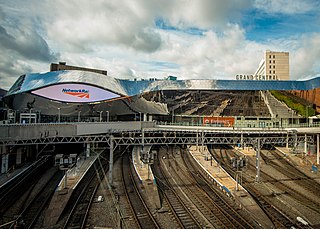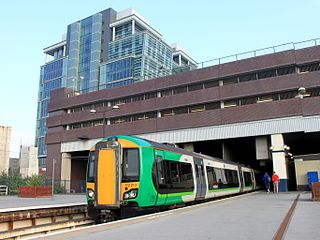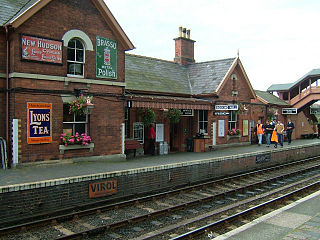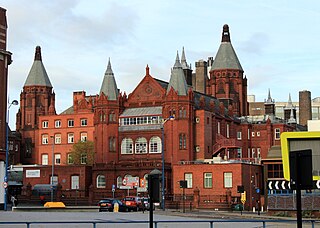
The Midland Railway (MR) was a railway company in the United Kingdom from 1844. The Midland was one of the largest railway companies in Britain in the early 20th century, and the largest employer in Derby, where it had its headquarters. It amalgamated with several other railways to create the London, Midland and Scottish Railway at grouping in 1922.

Birmingham New Street is the largest and busiest of the three main railway stations in Birmingham city centre, England. It is a central hub of the British railway system. It is a major destination for Avanti West Coast services from London Euston, Glasgow Central and Edinburgh Waverley via the West Coast Main Line, the CrossCountry network, and for local and suburban services within the West Midlands; this includes those on the Cross-City Line between Lichfield Trent Valley, Redditch and Bromsgrove, and the Chase Line to Walsall and Rugeley Trent Valley. The three-letter station code is BHM.

Birmingham Snow Hill is a railway station in Birmingham City Centre, England. It is one of the three main city-centre stations in Birmingham along with Birmingham New Street and Birmingham Moor Street.

The West Midlands is one of nine official regions of England at the first level of International Territorial Level for statistical purposes. It covers the western half of the area traditionally known as the Midlands. The region consists of the counties of Herefordshire, Shropshire, Staffordshire, Warwickshire, West Midlands and Worcestershire. The region has seven cities Birmingham, Coventry, Hereford, Lichfield, Stoke-on-Trent, Wolverhampton and Worcester. The largest towns in the region with large population centres are Bromsgrove, Burton-upon-Trent, Cannock, Dudley, Great Malvern, Halesowen, Kidderminster, Leamington Spa, Nuneaton, Redditch, Rugby, Shrewsbury, Solihull, Stafford, Stourbridge, Sutton Coldfield, Tamworth, Telford, Walsall and West Bromwich.

Birmingham has seen 1400 years of growth and during which time it has evolved from a small 7th century Anglo Saxon hamlet on the edge of the Forest of Arden at the fringe of early Mercia to become a major city. A combination of immigration, innovation and civic pride helped to bring about major social and economic reforms and to create the Industrial Revolution, inspiring the growth of similar cities across the world.
The Birmingham Post is a weekly printed newspaper based in Birmingham, England, with a circulation of 2,545 and distribution throughout the West Midlands. First published under the name the Birmingham Daily Post in 1857, it has had a succession of distinguished editors and has played an influential role in the life and politics of the city. It is currently owned by Reach plc. In June 2013, it launched a daily tablet edition called Birmingham Post Business Daily.
Warwick was a parliamentary borough consisting of the town of Warwick, within the larger Warwickshire constituency of England. It returned two Members of Parliament (MPs) to the House of Commons of England from 1295 to 1707, to the House of Commons of Great Britain from 1707 to 1800, and then to the House of Commons of the Parliament of the United Kingdom until 1885.

The Coventry Telegraph is a local English tabloid newspaper. It was founded as The Midland Daily Telegraph in 1891 by William Isaac Iliffe, and was Coventry's first daily newspaper. Sold for half a penny, it was a four-page broadsheet newspaper. It changed its name to the Coventry Evening Telegraph on 17 November 1941. On 2 October 2006, the Telegraph simply became the Coventry Telegraph, reflecting its switch to a morning publication.

Midland Red was a bus company that operated in The Midlands from 1905 until 1981. It was one of the largest English bus companies, operating over a large area between Gloucester in the south and Derbyshire in the north, and from Northampton to the Welsh border. The company also manufactured buses.

Bewdley railway station serves the town of Bewdley in Worcestershire, England. Until 2014, it was the administrative headquarters of the Severn Valley Railway, after which they were moved to Comberton Hill, Kidderminster. Bewdley is the principal intermediate station on the line.

The Daily News was a national daily newspaper in the United Kingdom.

The Birmingham Journal was the first newspaper known to have been published in Birmingham, England. Little is known of it as few records remain, but a single copy survives in the Library of Birmingham: Number 28, dated Monday May 21, 1733. It is assumed from this that the first edition was probably published on 14 November 1732.

The Northampton Chronicle & Echo is a local newspaper serving Northampton, England, and the surrounding towns and villages. It was published daily from Monday-Saturday until 26 May 2012 at a price of £0.48. It then began to publish one edition per week each Thursday for £1.00. It had a circulation of 17,483 in the first half of 2010, a year on year decline of 7.8%, and the decline continued into 2012. The paper is owned by JPIMedia.

Philip Henry Muntz was a British businessman and Liberal politician. He was a leading figure in the politics of the rapidly growing industrial town of Birmingham in the mid-nineteenth century.
The city of Birmingham, England is home to an evolving media industry, including news and magazine publishers, radio and television networks, film production and specialist educational media training. The city's first newspaper was published in 1732.

Birmingham General Hospital was a teaching hospital in Birmingham, England, founded in 1779 and closed in the mid-1990s.

Former Christ Church, Birmingham, was a parish church in the Church of England on Colmore Row, Birmingham from 1805 to 1899.

John Alfred Langford was an English journalist, poet and antiquary in Birmingham.

John Thackray Bunce was a British journalist and author. He served as editor of Aris's Birmingham Gazette from 1860 to 1862, and of the Birmingham Post from 1862 to 1898.

Joseph Frederick Ledsam was a Deputy Lord Lieutenant of Warwick, High Sheriff of Worcestershire (1848-1849) and deputy chairman of the London and North Western Railway (1849-1862).



















